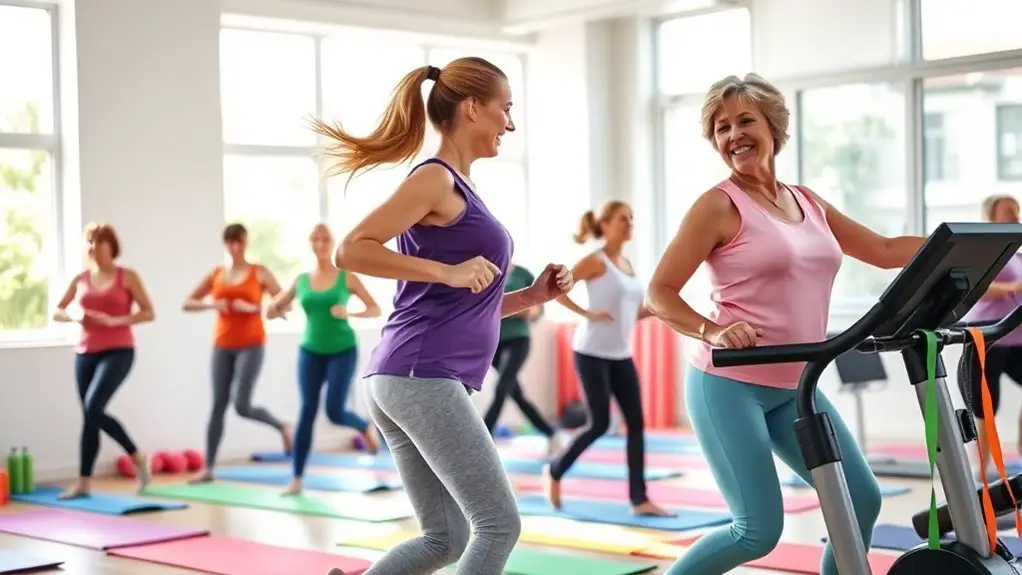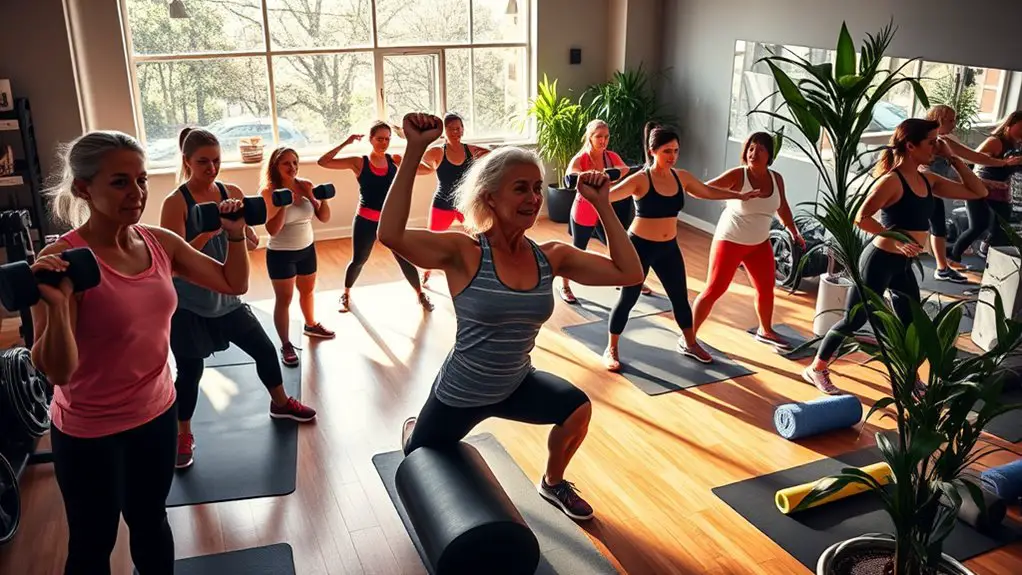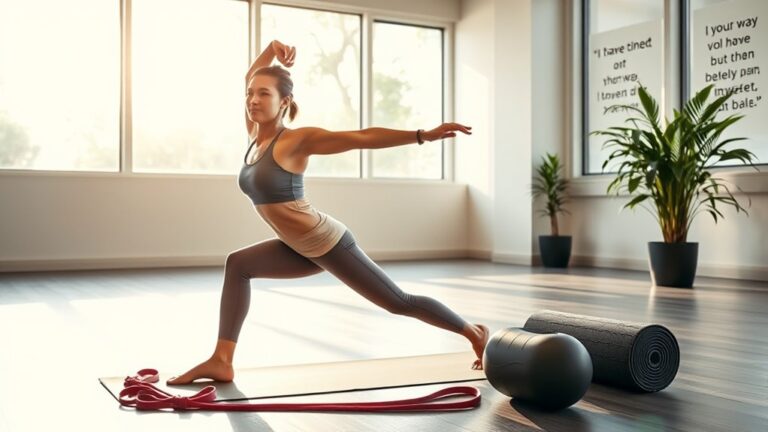The Best Gym Workout Plans for Women Over 40

The best gym workout plans for women over 40 focus on strength training, cardio, and flexibility. Prioritize strength exercises to build muscle and bone density while incorporating at least 150 minutes of aerobic workouts weekly for heart health. Don’t forget flexibility routines like yoga to enhance movement and prevent injuries. Rest days are vital for recovery and performance. By creating a balanced and sustainable routine, you’ll enjoy lifelong fitness benefits—discover more essential tips for your journey.
Understanding the Unique Fitness Needs of Women Over 40

As you reach your 40s, your body begins to experience changes that can impact your fitness routine. Hormonal changes may affect your metabolism, making it vital to adjust your nutrition focus. Incorporate nutrient-dense foods and consider smaller, more frequent meals to maintain energy levels. Lifestyle adjustments, like prioritizing sleep and stress management, can also enhance your overall well-being.
It’s essential to stay aware of potential injuries, as your body may take longer to recover. Engaging in low-impact exercises can be beneficial. Don’t underestimate the importance of social support, whether through workout buddies or fitness groups, to keep you motivated. Additionally, incorporating aerobic exercises can help regulate insulin levels and promote weight loss, which is crucial as you navigate these changes.
Lastly, remember that mental health plays a significant role in your fitness journey. Embrace the changes, celebrate small victories, and remain flexible in your approach. With the right mindset and adjustments, you can thrive in your 40s and beyond!
Essential Components of a Balanced Workout Plan
Creating a balanced workout plan is key to feeling your best and staying fit as you age. You’ll want to focus on strength training to build muscle, cardiovascular exercises to boost heart health, and flexibility workouts to keep your body moving smoothly. Each component plays an essential role in enhancing your overall well-being and ensuring you stay active and energized.
Strength Training Importance
While many women over 40 might focus primarily on cardio for weight loss, incorporating strength training is essential for overall health and well-being. Strength training benefits include increased muscle mass, improved metabolism, and enhanced bone density, which are vital as you age. Many believe that lifting weights will make them bulky, but that’s a common strength training myth; instead, it helps tone and sculpt your body. Additionally, strength training can boost your confidence by improving your physical capabilities. By integrating it into your routine, you not only elevate your fitness level but also support long-term health. So, embrace strength training to empower yourself and break free from outdated beliefs, ensuring you feel strong and vibrant at any age!
Cardiovascular Health Focus
Incorporating cardiovascular exercise into your workout routine is just as important as strength training for women over 40. Aerobic exercises like walking, cycling, and swimming can enhance your heart health, boost your energy, and help maintain a healthy weight. Aim to elevate your heart rate for at least 150 minutes a week, which can be easily achieved by breaking it into manageable sessions.
| Aerobic Exercise | Benefits |
|---|---|
| Brisk Walking | Improves endurance |
| Cycling | Builds leg strength |
| Swimming | Full-body workout |
| Dancing | Enhances coordination |
| Jogging | Boosts cardiovascular fitness |
Integrating these activities into your routine can lead to a healthier, happier you. Remember, consistency is key!
Flexibility and Mobility Exercises
Flexibility and mobility exercises play an essential role in maintaining overall health and well-being as you age. Incorporating yoga practices into your routine can enhance flexibility while promoting relaxation. Don’t forget the importance of dynamic stretches, which warm up your muscles and improve joint mobility, making daily activities easier. Foam rolling is another fantastic tool; it helps release muscle tension and improves blood flow, keeping your body agile. Aim to include these exercises at least a few times a week to maintain your range of motion and prevent injuries. Remember, it’s never too late to start focusing on flexibility and mobility—your body will thank you for it! Embrace these practices to feel stronger and more balanced in your everyday life.
Strength Training: Building Muscle and Bone Density
As you navigate your fitness journey after 40, strength training becomes crucial for not just building muscle, but also enhancing bone density. Incorporating resistance training into your routine helps combat the natural decline in muscle mass and bone density that often occurs with age. Focus on exercises that target major muscle groups, like squats, deadlifts, and bench presses.
Don’t underestimate the importance of muscle recovery; giving your body adequate time to rest is essential for growth and strength gains. Aim for at least two to three strength training sessions per week, ensuring you allow 48 hours between working the same muscle groups.
Cardiovascular Exercises for Heart Health and Endurance

While strength training is essential, don’t overlook the importance of cardiovascular exercises for your overall heart health and endurance. Regular aerobic activities can improve your cardiovascular fitness and boost your energy levels, making daily tasks easier.
Strength training is vital, but don’t forget that cardiovascular exercises enhance heart health and boost energy for daily activities.
Consider incorporating these low impact options into your routine:
- Walking or brisk walking: A great way to get moving without putting too much stress on your joints.
- Cycling: Whether on a stationary bike or outdoors, cycling is an enjoyable way to elevate your heart rate.
- Swimming: This full-body workout is gentle on your body while providing excellent cardiovascular benefits.
Aim for at least 150 minutes of moderate aerobic activity each week. Remember, finding something you enjoy will make it easier to stick with your routine. Prioritizing your heart health through these exercises can lead to a healthier, more active lifestyle. Additionally, incorporating jump rope workouts can further enhance cardiovascular fitness and endurance.
Flexibility and Balance: The Key to Injury Prevention
To prevent injuries and maintain a healthy lifestyle, incorporating flexibility and balance exercises into your workout routine is essential. As you age, your body naturally loses flexibility, making you more susceptible to injuries. This is where yoga benefits come into play; practicing yoga not only enhances flexibility but also improves your balance, helping to stabilize your core and lower body. Additionally, engaging in exercises like skipping rope can improve cardiovascular health, provided you listen to your body and avoid overdoing it during workouts. Balance exercises, like standing on one leg or using a balance board, further contribute to your overall stability. These exercises strengthen the muscles that support your joints, reducing the risk of falls and sprains. Including both yoga and balance work in your routine can lead to increased mobility and greater body awareness, allowing you to move confidently in daily activities.
Recovery Strategies for Optimal Performance

Effective recovery strategies are essential for maintaining ideal performance, especially for women over 40 who may experience longer recovery times. By prioritizing recovery, you can enhance your workouts and reduce injury risks. Here are key strategies to take into account:
- Active Recovery: Engage in low-intensity activities like walking or yoga to promote blood flow and aid muscle recovery.
- Nutrition Support: Fuel your body with balanced meals rich in protein, healthy fats, and carbohydrates to replenish energy stores.
- Sleep Optimization: Aim for 7-9 hours of quality sleep each night to allow your body to repair and rejuvenate.
Incorporating hydration strategies, foam rolling, and mindfulness practices can further enhance recovery. Additionally, focusing on stress management will help maintain your overall well-being. By implementing these strategies, you’ll not only improve your performance but also enjoy a healthier fitness journey.
Creating a Sustainable Workout Routine for Lifelong Fitness
Creating a sustainable workout routine starts with understanding your current fitness level and setting realistic goals that fit your lifestyle. It’s crucial to incorporate rest days to allow your body to recover and prevent burnout. By focusing on what works best for you, you’ll be more likely to stick with your routine for the long haul.
Assessing Individual Fitness Levels
How do you determine the right starting point for your fitness journey? Evaluating your individual fitness levels is essential for creating an effective workout plan. Begin with fitness assessments to identify your current abilities and establish personal benchmarks. This’ll help you tailor workouts that suit your unique needs.
Consider evaluating your fitness with these components:
- Cardiovascular endurance: Test how long you can sustain an activity like walking or cycling.
- Strength: Evaluate how many bodyweight squats or push-ups you can perform.
- Flexibility: Check your range of motion with stretches.
Setting Realistic Goals
While commencing your fitness journey, it’s crucial to set realistic goals that align with your lifestyle and abilities. Goal setting isn’t just about aiming high; it’s about creating achievable milestones that inspire you. Start by defining what you want—whether it’s improving strength, increasing endurance, or simply feeling more energized. Make sure your expectations are realistic; for instance, aim for gradual progress rather than drastic changes. Consider your schedule, preferences, and physical limitations. Tracking your achievements can help maintain motivation and keep you accountable. Remember, consistency is key; even small changes can lead to significant results over time. By establishing realistic expectations, you’ll create a sustainable workout routine that promotes lifelong fitness and well-being.
Incorporating Rest Days
Setting realistic goals is just the beginning of your fitness journey; equally important is understanding the role of rest days in your workout routine. Incorporating rest days isn’t just beneficial—it’s essential for sustainable fitness.
To maximize your workouts and enhance recovery, consider these key points about rest day importance:
- Muscle Recovery: Your muscles need time to repair and grow stronger after workouts.
- Mental Rejuvenation: Taking breaks can help prevent burnout and keep you motivated.
- Injury Prevention: Scheduling rest reduces the risk of overuse injuries, allowing for a longer, healthier fitness journey.
Frequently Asked Questions
How Often Should I Change My Workout Routine?
You should change your workout routine every 4 to 6 weeks to keep your body challenged and prevent plateaus. Incorporating progressive overload—gradually increasing weights or intensity—ensures you’re continuously making gains. Alongside this, adding workout variety helps maintain your motivation and targets different muscle groups. Experiment with new exercises, classes, or training styles to keep things fresh. Remember, staying engaged is key to long-term success, so don’t be afraid to mix it up!
Can I Lose Weight While Strength Training?
Isn’t it funny how people think strength training’s just for bulking up? In reality, you can absolutely lose weight while strength training. By creating a caloric deficit, you’ll shed pounds, all while building muscle retention. This balance helps keep your metabolism revved up. So, don’t shy away from those weights! Embrace the challenge, and you’ll find that strength training can be your secret weapon in your weight loss journey.
What Are the Best Gym Machines for Women Over 40?
When you’re considering the best gym machines, focus on those that support both resistance training and cardio options. Machines like the elliptical and stationary bike are fantastic for low-impact cardio. For strength, try resistance machines such as the leg press and seated row; they’ll help build muscle safely. Mixing these will not only boost your strength but also enhance your overall fitness. Remember, consistency is key to achieving your goals!
Should I Consult a Doctor Before Starting a New Workout?
Absolutely, you should consult a doctor before starting a new workout, especially if you have existing health conditions. They can help assess your overall fitness and recommend necessary fitness assessments. This way, you’ll avoid potential injuries and tailor your routine to your specific needs. Remember, it’s always better to be safe than sorry when it comes to your health, and your doctor can provide valuable guidance to enhance your fitness journey.
How Can I Stay Motivated to Work Out Regularly?
To stay motivated, remember the adage, “A journey of a thousand miles begins with a single step.” Find workout buddies who share your fitness goals; it makes exercising more enjoyable and keeps you accountable. Set small, achievable milestones, and celebrate each victory, no matter how small. Mix up your routine to keep things fresh, and remind yourself of the benefits you’re gaining, both physically and mentally, to maintain your enthusiasm.





